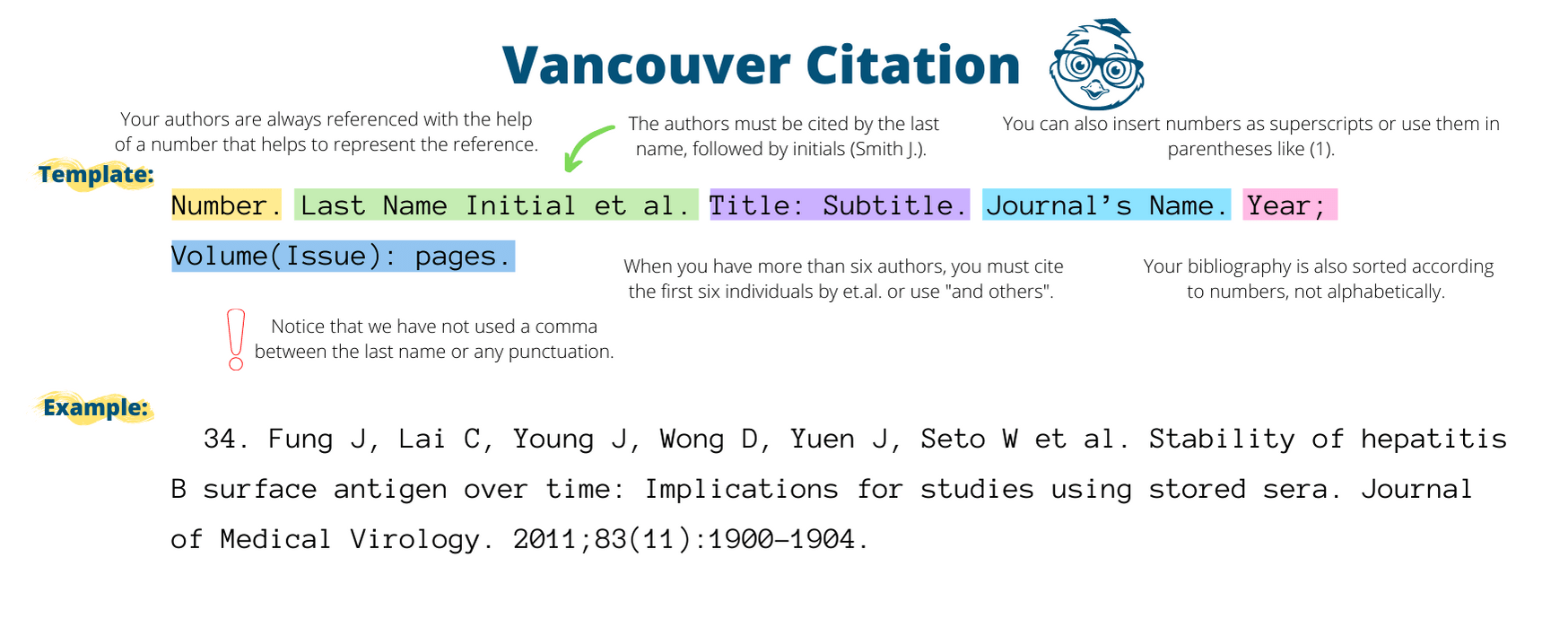
VANCOUVER CITATION
The Vancouver citation style is widely used in medical and scientific papers. It is a numbered citation style, meaning that in-text citations are represented by numbers, which correspond to entries in the reference list. The reference list is ordered numerically in the sequence in which sources are cited in the text.
1. In-Text Citations
In Vancouver style, in-text citations are indicated by placing a number in parentheses or superscript after the information being cited. The numbers appear in the order in which sources are first mentioned.
Format:
- (1), (2), etc. or [1], [2], etc.
- Superscript: ¹, ², etc.
Examples:
-
For a paraphrase:
Technology has revolutionized modern education (1).
According to Smith, technological advancements have significantly impacted education¹. -
For a direct quote:
"The rise of technology has reshaped learning environments" (2).
Smith argues that "technological progress will define the future of education"².
If the same source is cited multiple times, the same number is used for each occurrence throughout the text.
2. Reference List
The reference list in Vancouver style is numbered consecutively in the order that the sources are cited in the text. Each reference begins with its respective number. The list appears at the end of the document.
Format for Common Sources:
- Author(s). Title. Edition (if not the first). Place of Publication: Publisher; Year of Publication.
- Author(s). Title of the article. Title of the journal [Internet]. Year [cited date]; Volume(Issue): Page range. Available from: URL or DOI.
Examples for Different Sources:
Books:
In-text citation:
- (1)
Reference list entry:
- Format:
Author(s). Title of the book. Edition. Place of publication: Publisher; Year.
Example:
- Smith J. The evolution of technology. 2nd ed. New York: HarperCollins; 2020.
Journal Articles:
In-text citation:
- (2)
Reference list entry:
- Format:
Author(s). Title of the article. Title of the journal. Year; Volume(Issue): Page range.
Example:
2. Brown E. The influence of social media on mental health. J Psychol. 2019;12(3):34-45.
For online articles, include the DOI or URL:
- Format:
Author(s). Title of the article. Title of the journal [Internet]. Year [cited Date]; Volume(Issue): Page range. Available from: URL or DOI.
Example:
3. Brown E. The influence of social media on mental health. J Psychol [Internet]. 2019 [cited 2024 Jul 15];12(3):34-45. Available from: https://doi.org/10.1234/jpsy.2019.234.
Websites:
In-text citation:
- (3)
Reference list entry:
- Format:
Author(s). Title of the webpage. Website name [Internet]. Date of publication [cited date]. Available from: URL.
Example:
3. Johnson P. The impact of climate change on agriculture. The Environmental Blog [Internet]. 2020 Apr 10 [cited 2024 Jul 15]. Available from: www.environmentalblog.com/climate-change-agriculture.
Chapters in Edited Books:
In-text citation:
- (4)
Reference list entry:
- Format:
Author(s). Title of the chapter. In: Editor(s), editor(s). Title of the book. Edition. Place of publication: Publisher; Year. p. Page range.
Example:
4. Roberts A. New advances in AI. In: Green P, editor. Technology and innovation in the 21st century. London: Tech Press; 2021. p. 50-75.
3. Key Features of Vancouver Style:
- Numbered Citations: Sources are identified by a number in the text, which corresponds to a full citation in the reference list.
- Order of Sources: The reference list is numbered sequentially according to the order in which sources are first cited in the text.
- Abbreviated Journal Titles: Journal titles are often abbreviated according to the NLM (National Library of Medicine) guidelines, without punctuation.
- Minimal Punctuation: The Vancouver style minimizes the use of punctuation in citations, making it concise and efficient.
4. Special Cases in Vancouver Citation
- No Author: If there is no author, the title of the work takes the author's place at the beginning of the reference.
In-text citation:
(5)
Reference list entry:
5. The impact of technology on education. New York: Tech Publishers; 2020.
- Multiple Authors: If there are six or fewer authors, list all authors. If there are more than six authors, list the first six followed by "et al."
5. Why Use Vancouver Citation?
Vancouver citation is particularly useful in fields like medicine, biology, and other sciences, where sources are frequently cited in a straightforward and concise manner. Its numbered system allows for easy referencing without disrupting the flow of the text, and the concise format of the reference list is ideal for technical and scientific writing.
By adhering to Vancouver style, you ensure that your work is clearly documented, and that readers can easily follow and locate the original sources you used in your research.